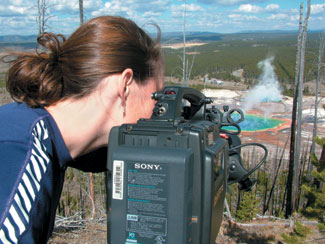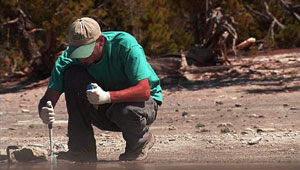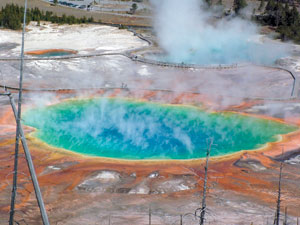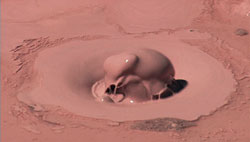




| Filmmaking Where Acting Natural Comes with the Turf | |
| By Kirk Johnson Reprinted with permission from The New York Times |
Science filmmaker Katy Garton ’01 doesn’t worry about praise going to her actors’ heads — they do not have any.
The scene was set, the camera was ready, and as luck would have it, sunlight broke through the clouds just as Katy Garton ’01 began filming. She adjusted the lens and her stars came into focus.
“Oh my God,” she said, her eye glued to the viewfinder. “They’re beautiful.”
 |
| Katy Garton ’01, a graduate student in science documentary filmmaking, peers through her viewfinder to find the best angle for filming the Grand Prismatic Spring in Yellowstone National Park |
This would never be confused for a Spielberg production, or even for the makings of a sleeper to be discovered on the independent film circuit. But then, Ms. Garton is not a typical aspiring filmmaker; she is a scientist enrolled in her second year at the nation’s only film school dedicated to science and natural history.
For her and the 50 other students in the three-year master’s degree program at Montana State University in Bozeman, success is not measured by Hollywood standards.
“The traditional focus of a film career is fame and fortune, neither of which naturally follows in this area,” said Ronald B. Tobias, a professor of media and theater arts who founded the program in 2001 with seed money from the Discovery Channel. The first students will graduate next year.
 |
| Garton captured Seth D’Imperio testing mineral-laden waters at Norris Geyser Basin. |
But if the values are different in this school, so are the payoffs. Ms. Garton, an avid biker, runner, and mountain climber whose most recent expedition was a six-week trip into the Andes with her sister, Rachel, studied physics as an undergraduate and once planned on a career as an astrophysicist.
She enrolled in film school, she said, when she realized that the rigors of science and joys of tromping through the wild in muddy boots could be combined.
“Sometimes it just strikes me that — wow, I could maybe do this all the time, and get paid for it,” Ms. Garton said as she hiked through Yellowstone one afternoon with a huge backpack containing the bulky high-definition television camera she uses.
Some of the student projects in the Montana State program have focused on hurricane tracking or the wildlife of Mongolia. Ms. Garton, who has received preliminary interest from the Discovery Channel for her unfinished film, is documenting the unusual life that has evolved in Yellowstone’s thermal springs, and the scientists who study it.
Her human star is Tim McDermott, a professor of environmental sciences at the Thermal Biology Institute at Montana State. The institute was founded specifically to study Yellowstone, and receives some of its financing from the exobiology branch of NASA, on the premise that life in the park’s pools might shed light on the possibilities of life beyond Earth.
 |
| The geothermally heated Grand Prismatic Spring steaming in the morning air. |
Dr. McDermott recently led Ms. Garton to what he said was the one place in Yellowstone — and one of the rare places on the planet — so harsh and so extreme that no life at all had been found in its depths.
It is called the Cinder Pool, named for the layer of sulfur ash that perpetually coats its surface. Molten sulfur bubbles up from the bottom, and the sinister concatenation of acid and heat and who knows what else is too much, apparently, even for Yellowstone’s hardy microbes. The stench at poolside was strong, the steam downwind overpowering.
Ms. Garton was thrilled. She lay prone on a tarp — the sulfuric acid-laced soil around the pool will eat through pants — and filmed Dr. McDermott scooping ash from the water and holding the crusty black fragments in his hand.
“OK, we’re rolling,” she said. “Just say it like you did before.”
So Dr. McDermott held forth about biology, and how places like Cinder Pool illuminate the deep strangeness of the world by creating a bright-line divider between the conditions that allow life to flourish in chaotic, exuberant abandon, and those — not so different, or so it would seem — that deny life a foothold.
“How was that?” he said.
“Perfect,” Ms. Garton said.
Professor Tobias, the film school’s founder, said the premise behind the program was that science filmmakers should be scientists. Only directors with science backgrounds, he said, could critically analyze their material and challenge, if need be, the pronouncements of other scientists. About 85 percent of the students have what he called “hard science” degrees in fields like chemistry, biology, or physics, though the program has also admitted a few people with social science backgrounds in anthropology or political science.
 |
| A mud pot bubbling away. |
Changes in technology and education will create a vast appetite for science documentaries over the next decade, he said, and most of the jobs making those films will not be in television. Interactive education will eventually be the norm in classrooms, Professor Tobias said, creating demand for Internet content. Environmental groups, universities, and government science agencies will want sophisticated video press releases. Science museums will demand programming for their theaters.
Ms. Garton, for now, is content to hone her craft. She studies everything she can, she says, to better understand the art of storytelling and pacing. Small things still trip her up occasionally.
“Sometimes I forget to breathe when I’m trying to get a shot,” she admitted.
But she is already dreaming big, or at least big by the standard of science filmmaking. Someday, she said, she would like to have a budget ample enough to hire people to carry the heavy equipment to remote places. “I’m going to have a real crew,” she said.
The Colorado College | 14 East Cache La Poudre Street | Colo Sprgs, CO | 80903 || 719-389-6000